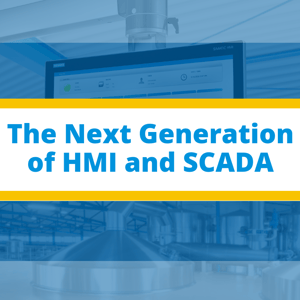 The age of Industrial IoT is upon us and HMI/SCADA systems face new challenges pertaining to their integration with modern technological marvels such as Big Data, Cloud, IoT, predictive analytics and 4G/LTE, etc.
The age of Industrial IoT is upon us and HMI/SCADA systems face new challenges pertaining to their integration with modern technological marvels such as Big Data, Cloud, IoT, predictive analytics and 4G/LTE, etc.
The HMI software market has been hit hard by the advent of IoT, shaping its very development and resultant features. For some, SCADA systems are bound to become obsolete as edge computing takes over, with the intelligence become distributed rather than recouping in a central location. These thoughts are backed by the rise in AI engines, cloud computing capabilities and digital twins, disrupting conventional industrial schemes.
First, one should know that there is a very clear (yet forgotten) difference between HMI and SCADA, with the former being a closer counterpart of an individual operator and latter acting as a central control for an entire plant. Even though SCADA provides a comprehensive solution for monitoring, control, automation and reporting, several vendors sell HMIs, historian software, reporting tools and alarm software along with higher-level applications, e.g. MESs, analytics, etc. This means there’s a redundancy in the market regarding the functions and features of SCADA systems.
With new technologies such as IoT coming into play, HMI/SCADA software is becoming more mission-critical. The room for errors is decreasing as even a minute mistake can have a big impact over the plant floor. IoT devices, as one may call them, give users access to lots of useful data along with a higher refresh rate. This seems beneficial from a business standpoint but is sometimes hard to implement from the technical point of view. The next generation of HMI/SCADA hardware and software aim to address such technical challenges.
Connectivity
As digitization continues, availability of energy-efficient Ethernet and Wi-Fi networks becomes a reality. This allows equipment to be distributed further across the factory floor, and even be made “mobile” for added flexibility. As stated earlier, edge-located IoT devices are becoming the norm, spurring issues for traditional connectivity schemes. In a typical factory arrangement, data follows a path similar to this:
- Sensor
- PLC
- OPC Server
- PC based HMI/SCADA
- Gateway
- Reporting/charting system
On the other hand, HMI/SCADA systems of the future will flatten out such a tall hierarchy, leaving only three pieces behind:
- Sensor
- Groov EPIC
- Cloud or on-premises applications
Hardware
The hierarchy stated above can take advantage of modern open-source hardware and software platforms that don’t tie factory managers to a specific standard. Specialized elements can be superseded with standard building blocks.
Moreover, the development of edge technologies mean that newer platforms are embedded with sufficient connectivity and processing power, eliminating the need for layers of PLC servers and PCs. When we say, “edge component”, we mean an entity that borrows features from a PLC, PC and HMI, functioning as an industrial controller.
Each edge component possesses the ability to act as a bridge for other intelligent devices all the way up to the cloud. From thereon, they can form the core of the new architecture on top of which HMI and SCADA is built.
Software
Hardware alone isn’t enough to bridge the gap between IoT devices and HMI/SCADA systems. Instead, developers would have to rely on numerous open-source and built-in software technologies, namely:
- Linux OS
- Native OIT/HMI options
- OPC UA drivers
- Improved licensing
- MQTT/Sparkplug
Windows continues to be a popular choice for HMI and SCADA manufacturers, but in recent years it has faced stiff competition from the open-source alternative Linux that promises greater security and stability. Much of the development taking place on IoT and smart devices is based on Linux, Ubuntu being a popular distro.
OPC UA drivers are built into many components shipped out today, facilitating native communications between edge devices and popular PLCs. This allows the power of IoT devices to be reaped out to the fullest level. Finally, security is being made firmer through technologies such as MQTT that allows secure inbound/outbound communications to take place. It can operate seamlessly over typical business IT systems, avoiding complex and stiff network configurations. MQTT is often used in conjunction with Sparkplug that effectively delivers industrial-type messages throughout the plant.
The future is exciting to say the least and is already here; technologies such as those mentioned above have already started shifting the traditional route of HMI/SCADA development, something that will only pick up pace with the passage of time.
Interested in learning more? Visit our website www.premierautomation.com, or talk to one of our specialists today.



